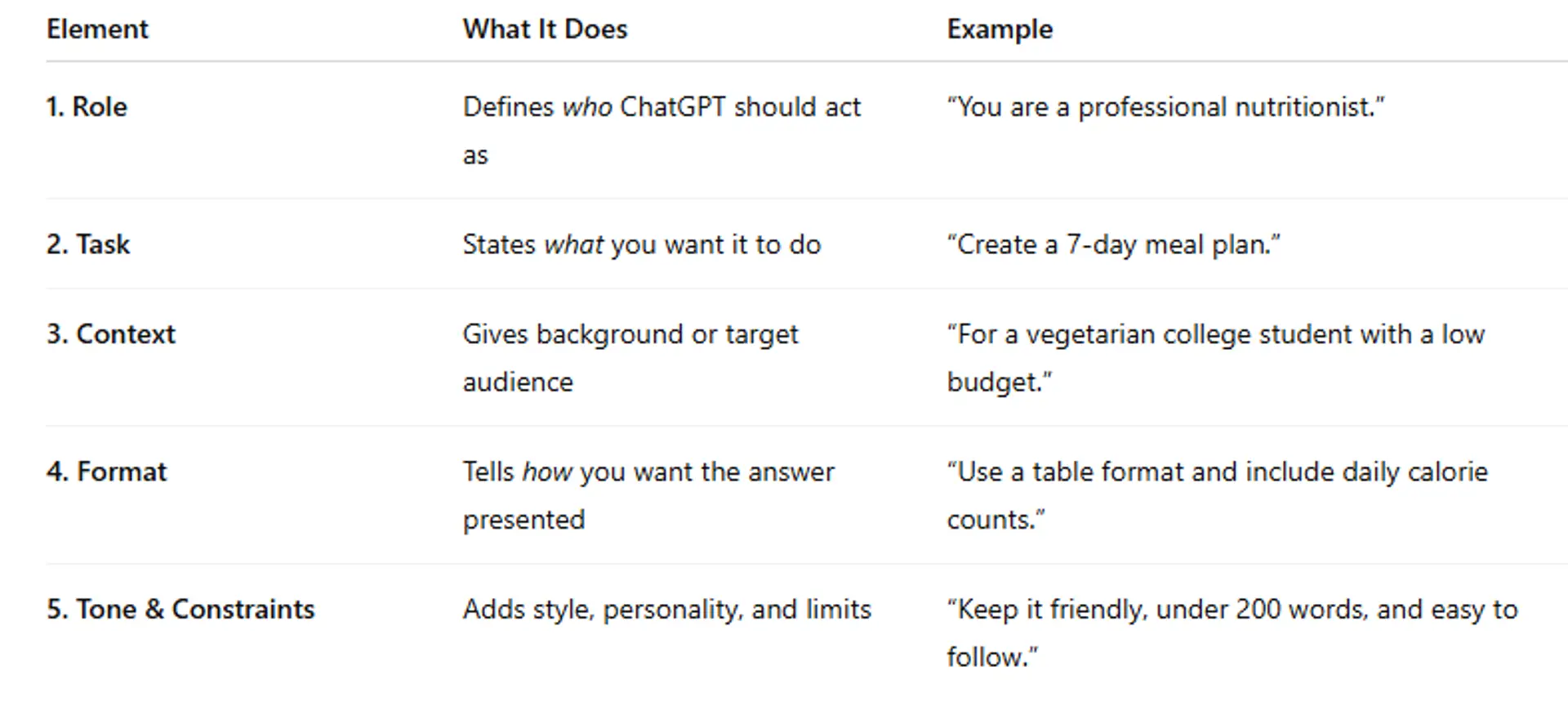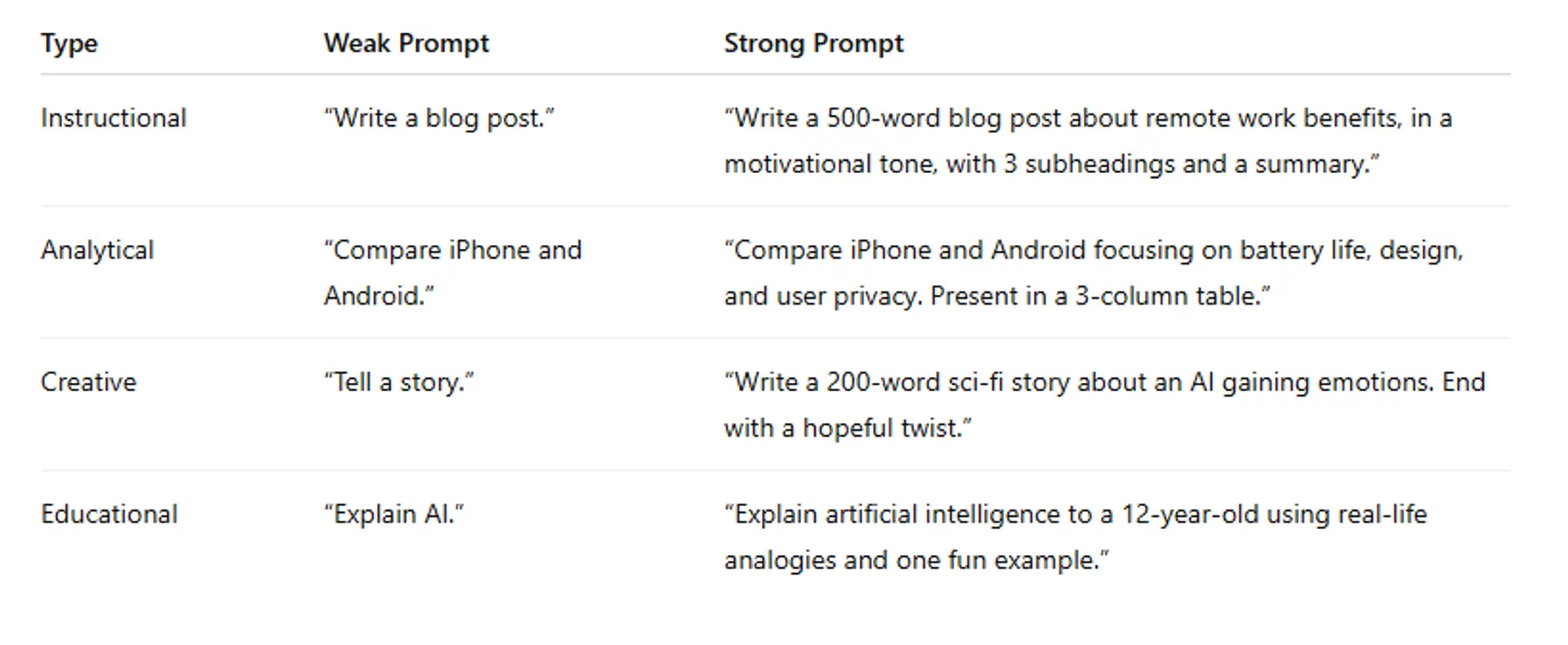

Module 2: Prompt Engineering Basics, Lesson 2.1 — Anatomy of a Good Prompt
Module 2: Prompt Engineering Basics
Lesson 2.1 — Anatomy of a Good Prompt
Lesson Objective
By the end of this lesson, you will be able to:
- Understand what separates an average prompt from a powerful one.
- Identify and apply the five building blocks of an effective prompt.
- Craft prompts that produce consistent, accurate, and creative responses across ChatGPT-3.5, 4, and 5.
1. Why Good Prompts Matter
Imagine giving instructions to a world-class chef:
- If you just say, “Make food,” you’ll get something edible.
- But if you say, “Make a creamy mushroom pasta for dinner, light on salt, and serve it warm,” — you’ll get exactly what you want.
ChatGPT works the same way.
It’s capable of brilliant results — but only if you tell it clearly, completely, and creatively what you need.
Bad Prompt: “Write about AI.”
Good Prompt: “Explain artificial intelligence to a high school audience using simple language, real-world examples, and under 150 words.”
The difference? Direction.
2. The Five Elements of a Perfect Prompt
Every powerful prompt follows a structure — a recipe for precision.
Let’s break it down:

Complete Prompt Example:
“You are a professional nutritionist. Create a 7-day vegetarian meal plan for a college student on a budget. Present it in a table format with daily calorie counts. Keep it friendly and under 200 words.”
✅ This single prompt guides ChatGPT’s role, task, audience, tone, and output — ensuring results that feel polished and human.
3. How ChatGPT Interprets Your Prompt (Behind the Scenes)
When you submit a prompt, ChatGPT doesn’t think — it predicts. It analyzes patterns in your language to infer your intent.
A well-structured prompt gives the model everything it needs to make accurate predictions.
A vague one leaves it guessing.
Example:
“Describe Paris.” → Random facts or general info.
“Describe Paris as a travel blogger visiting for the first time. Focus on food, culture, and hidden gems.” → Engaging, immersive narrative.
💡 Lesson Insight: The more context you give, the more control you have over ChatGPT’s voice, style, and accuracy.
4.Building Your Own Prompt — Step-by-Step Framework
Use this 4-step method to design powerful prompts every time:
Step 1️⃣ — Define Your Goal
“I want ChatGPT to write a product description for a new smartwatch.”
Step 2️⃣ — Add Context
“It’s for fitness lovers who like smart gadgets.”
Step 3️⃣ — Specify Tone & Format
“Use an enthusiastic tone, three sentences, and one emoji.”
Step 4️⃣ — Combine Everything
“You are a marketing expert. Write a 3-sentence product description for a new smartwatch designed for fitness enthusiasts. Use an enthusiastic tone and include one emoji.”
Result: A clear, vivid, and on-brand response — every single time.
5. Comparing Weak vs Strong Prompts

💡 The more precise the prompt, the more relevant, creative, and trustworthy the result.
6.Version-Specific Prompt Behavior

💬 Tip: When using GPT-3.5, simplify prompts. GPT-4 and GPT-5 can interpret layered or chained prompts more effectively.
7. Learn More with the Videos Below
Learn from industry experts who mastered prompting:
🎥 Prompt Engineering for Beginners
🎥 How to Write Perfect Prompts for ChatGPT
🎥 Advanced Prompt Tricks for ChatGPT
🎥 30 ChatGPT Hacks You Need to Know in 2025
Lesson Quiz 2.1
Please complete this quiz to check your understanding of the lesson. You must score at least 70% to pass this lesson quiz. This quiz counts toward your final certification progress.
Answer the quiz using the Google Form below.
Conclusion
A great prompt is more than just a question — it’s a conversation starter, a creative spark, and a blueprint for brilliance.
By mastering the anatomy of a prompt, you’re unlocking the key to making ChatGPT respond like a professional partner — not just a chatbot.
Next, we’ll take this foundation even further in Lesson 2.2 — Role-Playing & Personas in ChatGPT, where you’ll discover how to give ChatGPT personalities and roles that transform your results from generic to genius.
Previous and Next Lessons:
Module 1: Introduction & Fundamentals, Lesson 1.3 — Understanding Prompts and How ChatGPT Thinks
Module 1: Introduction & Fundamentals, Lesson 2.2 — Role-Playing & Personas in ChatGPT
Related Posts
© 2025 Invastor. All Rights Reserved

User Comments